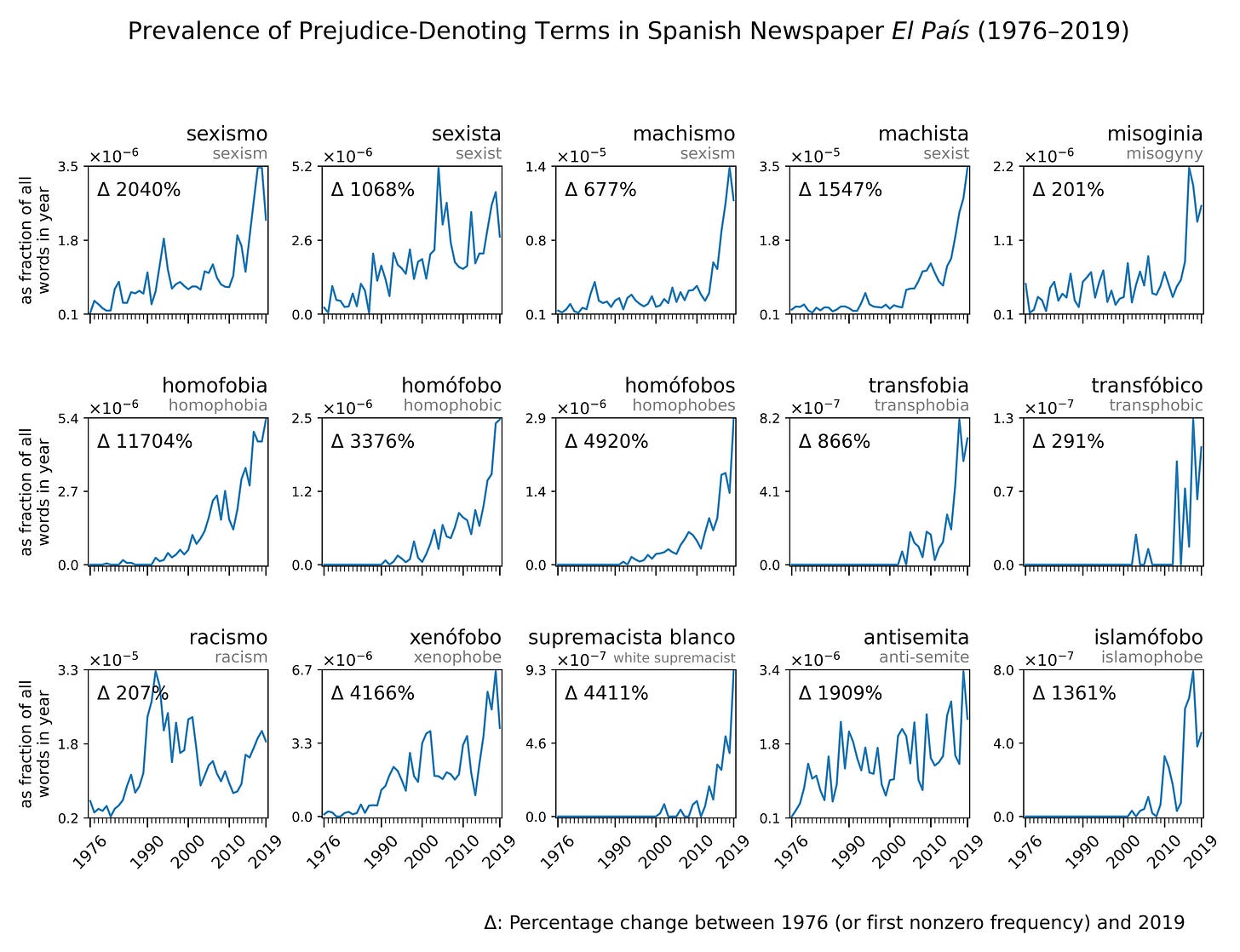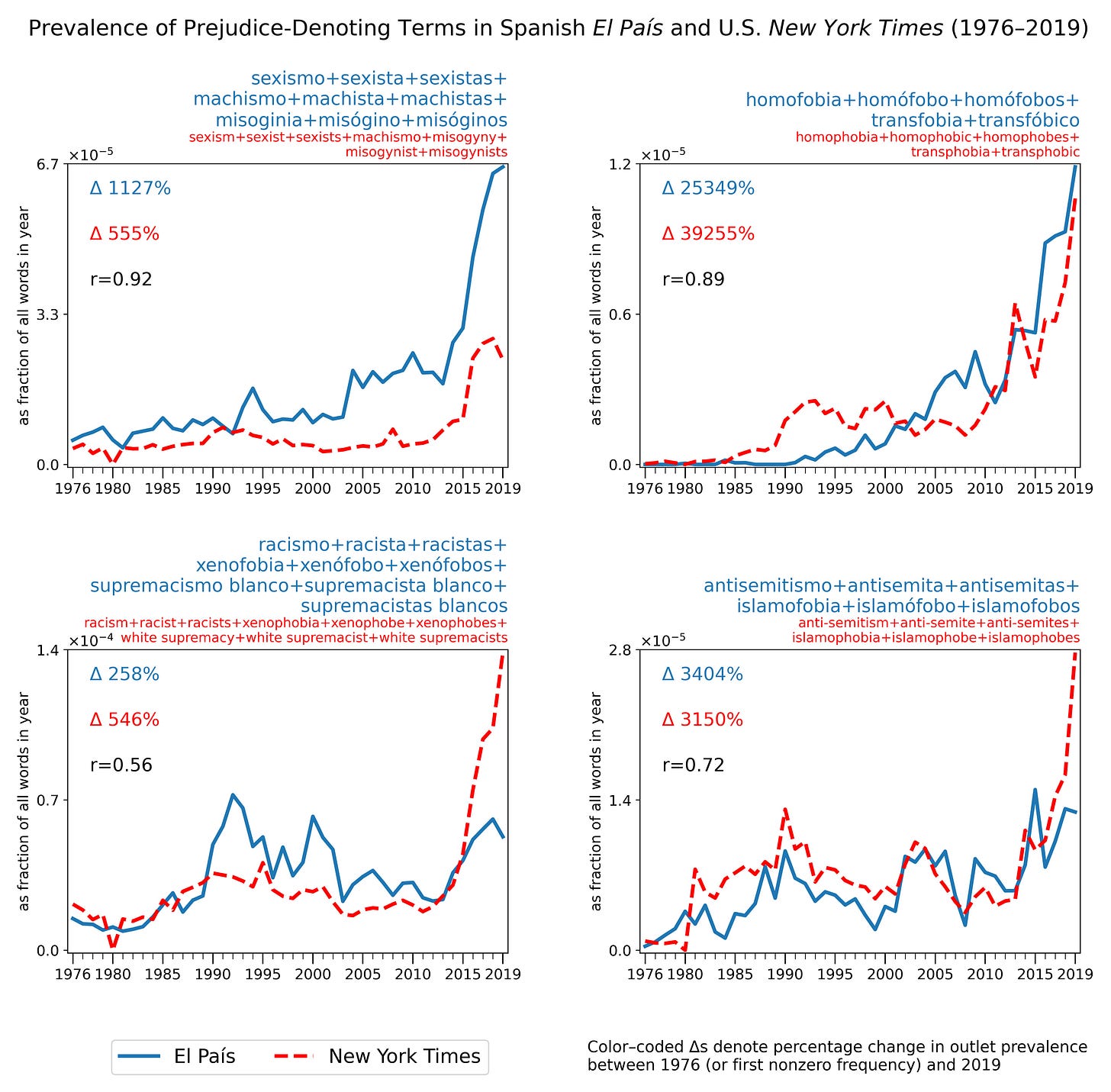The Prevalence of Prejudice-Denoting Terms in Spanish Newspapers
Introduction
Previous scholarly literature here and here has documented a pronounced increase in the prevalence of prejudice-denoting terms in American news media content. Some have referred to this shift in journalistic discourse and related public opinion trends signaling increasing perceptions of prejudice severity in U.S. society as The Great Awokening. In a recent published work, we analyzed whether the increasing prevalence of prejudice themes in American news media outlets has been replicated in the news media ecosystem of a Spanish-speaking country.
We computationally analyzed the prevalence of words denoting prejudice in five million news and opinion articles written between 1976 and 2019 and published in three of the most widely read newspapers in Spain: El País, El Mundo and ABC. Conveniently, the three newspapers span the ideological spectrum of Spanish mainstream politics.
Results
The prevalence of terms denoting prejudice against gender, sexual orientation, gender identity, ethnicity and religious sentiment has markedly increased in the Spanish newspaper of record, El País, since 1976. Some of the target terms, such as sexist or anti-semite, appear to show a gradual increase in prevalence since the 1980s, whereas others show a more abrupt increase in prevalence, only starting in the early 2010s (i.e., white supremacist or misogyny).
We next compared the usage dynamics of aggregate sets of related prejudice-denoting terms across three widely read Spanish newspapers: El País, El Mundo and ABC. The online availability of news articles in the online domains of El Mundo and ABC only starts in 2002 and 2001, respectively. Hence, to maintain temporal consistency across newspapers, we circumscribed the next analysis to the temporal window 2002–2019.
We next analyzed the overall prevalence dynamics of prejudice-denoting terms in the Spanish newspaper of record, the left-leaning El País, and its U.S. counterpart, The New York Times.
Conclusion
Our results have documented a marked increase in the prevalence of prejudice-denoting terms across a large and representative set of written news articles from Spain’s most popular newspapers of record. Our analyses reveal that the dramatic increasing prevalence of prejudice-denoting terms previously noted in American news media is also happening in leading Spanish newspapers. The increase in frequency of words that denote prejudice against minorities and protected groups is ubiquitous across a set of newspapers spanning the mainstream ideological spectrum of Spanish politics. However, the noted trends appear less prevalent in the right-leaning newspaper ABC. Indeed, both left-leaning El País and centrist-leaning El Mundo show a high degree of synchronicity in the temporal dynamics with which they use prejudice-denoting terms, perhaps suggesting substantial journalistic alignment in the coverage of these topics between both outlets.
We have identified an important distinction between the Spanish newspaper of record, El País, and its U.S. counterpart The New York Times. Although for most prejudice themes, the time series of prejudice-denoting terms in both outlets are highly correlated, this is less apparent, but still substantial, for words denoting ethnic prejudice. Since 2015, thematic prevalence of ethnic prejudice is much milder in the Spanish newspaper. In recent years, the rate of increase of this topic in El País is also weaker than that of its counterpart in the United States. This perhaps reflects the heightened racial tensions that have engulfed the United States in recent years.
In contrast, the overall prevalence of terms denoting gender prejudice is substantially larger in El País than in its New York Times counterpart. The rate of increase in this topic is also larger in the Spanish newspaper. This could suggest that concerns around gender prejudice are more acute in Spanish society or within Spanish newsrooms.
In conclusion, the presented analysis has documented a marked increase in the prevalence of prejudice-denoting terms in three widely read Spanish newspapers. The dramatic increases in such words’ frequencies, particularly post-2010, and the existence of similar trends in news outlets from the United States, suggest the existence of powerful international journalistic or social dynamics at play which span across borders and language barriers.




